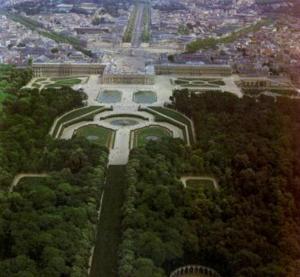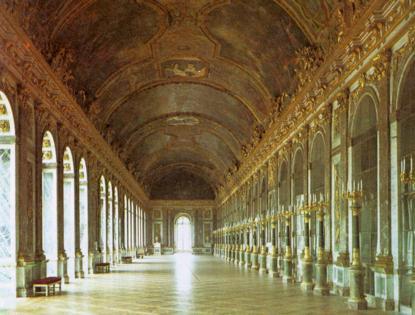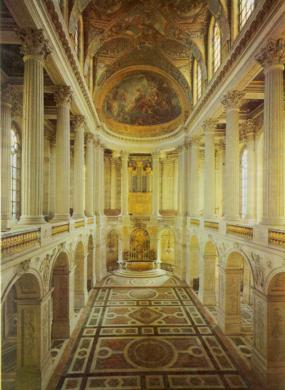
City, palace and park near Paris, France, built mainly 1668 - 1710.
The city of Versailles grew around the immense palace built a short distance from Paris on the order of king Louis XIV. With its 415 m of facade, its terraces, water works, vast gardens and parks the palace is one of the most harmonious designs of classicist architecture. It is also the incarnation of the absolutist monarchy, with the king's bedroom at the centre of the arrangement of buildings, avenues, forests and indeed of the entire city - the architectural expression of the king's statement "L'état, c'est moi" ("I am the state").
The original Palais de Versailles was a small royal hunting residence built inmidst marshy forests in 1623. It was modified in 1634 and is still retained in that form inside the Court de Marbre (Marble Court) of the present palace. It shrinks into near-insignificance against the splendour of the Hall of Mirrors or the Chapel.
Overall responsibility for the project rested with the painter Le Brun, who supervised all building activity for 15 years. The plan for the palace was designed by Le Vau, who died during the building period in 1670. His successor François D'Orbay continued with his plan. The garden architect Le Notre was responsible for the park design.
Louis XIV made Versailles the seat of government. Houses were built for the 20,000 persons attached to the court. About 1,000 of them and their 4,000 servants lived in the palace itself. By the time of the king's death the city of Versailles had about 30,000 inhabitants.
Louis XV, the successor to Louis XIV, continued the building activity, concentrating on the decoration of the interior in the elaborate rococo style. Extravagant spending on renovations in neo-classicist style continued to the day of the French Revolution.
The palace was restored and turned into a museum for the public in 1837. When Bismarck provoked a war with France in 1870 the German army used the palace as its headquarters, and the king of the new German empire was crowned in Versailles. After the war the palace served for a number of years as the seat of parliament. The peace treaty that ended World War I (the Treaty of Versailles) was signed in the palace.
Today Versailles is one of France's most distinguished tourist destinations, and the palace is used to receive and accommodate state visitors.

Versailles, the palace and the park.
The city of Versailles in the background is in the direction of Paris. The park in the foreground connected in the 17th century with large forests, which housed other royal palaces and hunting lodges. The Colonnade of 36 purple, red and blue marble columns in the near foreground was built in 1685.

The Hall of Mirrors.
This room of 73 m length looks out towards the park. Opposite its 17 windows are 17 mirrors of the same size, which produces an intensely luminous effect. The Hall of Mirrors was built by Jules Hardouin-Mansart in 1678 - 1684.

The Chapel.
The Chapel was the last room in the palace built under Louis XIV. Jules Hardouin-Mansart commenced it in 1689, Robert de Cotte completed it in 1710. It is set inmidst other buildings and barely noticeable from outside. The upper level connects directly to the king's rooms.